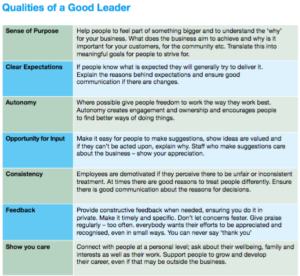If you are a business owner or manager you are responsible for leading others in pursuit of the organisation’s success. Whether it’s a small business with a few employees or a large entity with multiple divisions, if you are the leader of a team you are having an impact on a daily basis by what you do, or don’t do. I rather like this quote; “All leaders lead by example…. whether they intend to or not.” (Source Unknown)
It’s important for leaders to take time out occasionally to reflect on how well they are doing at being the boss. In a large organisation there is generally data and processes available to help with this. There are likely to be higher levels of management or a board of directors that will go through a structured performance review process with you that also requires some personal reflection.
This may also include some 360 degree feedback from peers and staff that provide you with insights about your leadership. There may be periodic staff engagement surveys that provide feedback about aspects of leadership. You may have access to turnover data, exit interviews and other useful indicators of the effectiveness of your people management and it is paramount that you use these information sources to mould your leadership approach.

Contrastingly, in a small business you probably won’t have the types of processes in place that a large entity typically would and it’s likely you will have less opportunity for reflection as small business owners are often busy with operations, marketing, finance, HR and all the things small business owners need to do. So how can you get some insights to develop your leadership skills?
- If you have performance reviews for your staff use the opportunity for 2-way feedback and ask about what you can do more of or less of to help them in their work.
- Consider using a business mentor as a sounding board about your leadership style and to provide suggestions for
improvement and contribute ideas to help you through challenging situations. Just having these conversations makes you reflect on how you are doing.
- Try to fit in some learning opportunities for yourself to get inspired, be exposed to new ideas, keep up to date with emerging trends, or learn from the experience of others. Training and ongoing development is just as important for leaders as for your staff. This could be a seminar, conference, academic course, on-line learning, or speakers at local business events.
- Endeavour to set aside time for personal reflection. What is it that your staff have been telling you? What tasks do you need to follow up on in order to provide your team with sound leadership and ensure they feel valued and listened to?
When you are able to set aside some time for personal reflection regarding your leadership and the productivity of your team try some of the tips above of some of the things a good leader provides, adapted from an article by Jeff Haden, entrepreneur and author. Consider how you are performing in these areas – there may be one or more aspects that you could consciously plan to do more of, changes you could easily implement, or even ‘big picture’ elements you may want to think further on to have a positive impact on the people working for you.
